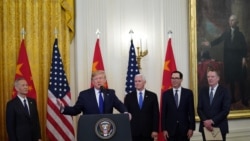On January 10, U.S. Secretary of Agriculture Tom Vilsack said the United States would continue to press China for “complete enforcement and complete implementation” of a trade deal inked two years ago.
The administration of former President Donald Trump struck the deal with Beijing in January 2020 after rounds of tense negotiations and a tariff feud. Under the agreement, China agreed to expand purchases over two years of certain U.S. goods and services by $200 billion.
With the period expiring at the end of 2021, data show that China fell well short.
In response to Vilsack, China’s state-run newspaper Global Times published an editorial the next day alleging the “repeated use of the [trade] agreement as a weapon to pressure China.”
“In fact, despite the US' reckless trade war that goes against basic economic rules and the trend of globalization and its malicious crackdown, China has strived [SIC] to overcome the difficulties caused by the pandemic and implemented the phase one trade agreement,” the Global Times said.
That is misleading.
To be sure, China did ramp up purchases of goods and services. But trade data from both Bloomberg and the Peterson Institute for International Economics (PIIE) showed that, as of the end of November 2021, purchases met only 60 percent of China’s pledge.
The Phase One deal set specific targets for Chinese purchases of U.S. agricultural, manufactured and energy products and certain traded services.
“[H]ere's the deal with Chinese friends, they're about $16 billion light over what they committed to purchase [U.S. agricultural products]. And that's why Ambassador Tai, our U.S. trade representative, is going to China and continues to converse with China about the necessity of living up totally and completely to the Phase One trade agreement, making up that $16 billion deficit over the course of the next several years,” said Vilsack at the American Farm Bureau Federation's annual convention in Atlanta on January 10.
Reuters reported that Vilsack said on January 11 that “the U.S. will continue to press China on the need for complete enforcement of the trade deal before discussing extensions.”
According to PIIE’s calculations, as of November 2021, China was 22 percent short on its agriculture goal, 44 percent short on the manufactured goods goal, and 65 percent short on the energy goal.
For U.S. agricultural exports, China pledged to buy $73.9 billion in the two-year period, but had actually purchased $57.4 billion as of November 2021.
For U.S. manufactured product exports, China bought $117.8 billion from 2020 through November 2021, falling well short of the $210.7 billion needed to meet the target.
For U.S. energy exports, the purchase target set in the trade deal was $67.7 billion, but as of November 2021, China had only bought $24 billion.
The PIIE tracker did not include data on China’s purchases of certain services from the United States. The Wall Street Journal separately reported that annual data showed a 32 percent drop in U.S. service exports to China for 2020.
China has blamed pandemic-induced supply chain disruptions for the shortfalls, while according to The New York Times, “it is unclear how receptive the Biden administration is to that argument or whether the president will take action against China for not living up to its end of the deal.”
Experts said it’s not surprising that China failed to meet such ambitious purchasing targets.
“Obviously the pandemic started early in 2020, but a big chunk of it was just that the targets were unrealistic to begin with,” Chad P. Bown of the PIIE told the Times in December.
“There was no chance China would be able to, in essence, double its [purchase of] U.S. exports in two years,” wrote Forbes trade columnist Ken Roberts.
But Jamieson Greer, former chief of staff to U.S. Trade Representative Robert Lighthizer during the Trump administration, told the Journal that U.S exports to China, despite missing the targets, were still strong in 2020 and 2021.
“It’s preferable to have high targets and achieve historic exports like we did in 2020 and 2021 thanks to the phase one deal, as opposed to hoping that China will simply start buying what we are selling based on market principles,” said Greer.
Though falling short on its pledges, data indeed show that U.S. exports to China are at a record level.
Roberts said that exports saw an 18 percent increase when comparing the first 10 months of 2021. Through last October, U.S. exports to China totaled $121.6 billion, which is doubling the total of the first 12 months of 2009.
The Journal reported that U.S. beef, pork, and poultry producers sold record amounts to China in 2020 or 2021, and while other farm exports fell short, they were still near records. China imported $14.1 billion of soybeans in 2020, only slightly below the $14.2 billion record in 2016.
Purchases of U.S. semiconductors exceeded the trade deal target, an exception. Bown at PIIE told South China Morning Post (SCMP) that Chinese companies like Huawei have stockpiled U.S. semiconductors over the past two years, anticipating that the U.S. might ban exports to China on national security grounds.
Purchasing commitments are just one part of the trade deal. Phase one also stipulated terms and pledges on structural reforms on intellectual property protection, financial services, macroeconomic policies and exchange rate matters and transparency.
Given that China’s state-owned enterprises have been behind the record agricultural purchases, some experts see irony in the trade deal.
“This would have necessitated a degree of state intervention in the market to make up for the absence of ‘genuine demand.’ And that runs counter to the US’ overall gripes with China’s economic model,” Nick Marro, lead global trade analyst at the Economist Intelligence Unit, told SCMP.
Scott Kennedy, a senior adviser at the Center for Strategic and International Studies (CSIS) told the Journal that the purchase targets reinforced Chinese state control. “It empowers all the wrong parts of the Chinese system that we want to disappear,” he said.

